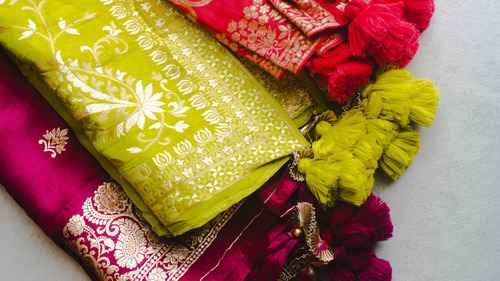What makes traditional Indian textiles so captivating? How did the intricate patterns and vibrant colours of Indian fabrics come to be? One of the most fascinating and historically rich textiles is the Kani weave, a true testament to the artistry and cultural heritage of India.
Kani sarees originate in the picturesque valleys of Kashmir. These exquisite drapes are renowned for their detailed designs and vibrant colours. It makes them a favourite among connoisseurs of traditional Indian attire. The detailed craftsmanship involved in creating these garments speaks volumes about the rich cultural tapestry from which they originate.
A Glimpse into History
Ancient Beginnings
The Kani weaving technique dates back several centuries. Initially, this method was used to create luxurious shawls for royalty and nobility. The craft was highly revered and often passed down through generations within weaving families. It ensures the preservation of the intricate skills required to produce these beautiful textiles.
Cultural Significance
Kani weaving holds immense cultural importance in Kashmir. Each piece is not just a garment but a work of art that tells a story. The patterns often depict elements of nature, such as flowers and vines, symbolising the region’s natural beauty. These textiles were traditionally worn during significant cultural and religious events, showcasing the wearer’s status and taste.
The Craftsmanship Behind Kani Weaving
Intricate Technique
The creation of these textiles involves a unique weaving technique using small wooden sticks known as ‘kanis’. The weaver meticulously places these sticks across the loom to create intricate patterns. This method is time-consuming, often taking several months to complete a single piece, but the result is a masterpiece of textile art.
Material and Design
These garments are typically made from high-quality pashmina or wool, which contributes to their luxurious feel. The designs are carefully planned and executed, often involving multiple colours and complex motifs. This level of detail requires a high degree of skill and patience from the weavers.
Modern Revival and Popularity
Contemporary Adaptations
Recently, traditional Kani weaves have resurged in popularity. Modern designers have incorporated these intricate patterns into contemporary fashion, creating a blend of tradition and modernity. This revival has helped bring global attention to this ancient craft, ensuring its survival and relevance in the fashion industry.
Global Appeal
The unique beauty and craftsmanship of these textiles have garnered international acclaim. Fashion enthusiasts and collectors around the world seek out these garments for their exquisite designs and rich cultural heritage. This global recognition has also provided economic opportunities for the artisans who continue to practice this age-old craft.
The Symbolism of Patterns
Nature and Harmony
The motifs used in Kani sarees often represent elements of nature, reflecting the weavers’ surroundings and cultural context. Flowers, vines, and paisleys are common, symbolising growth, harmony, and prosperity. These prints are not merely decorative but carry deep cultural meanings and traditions.
Spiritual and Cultural
Many designs also incorporate elements that hold spiritual significance. Certain patterns might be used during festivals and religious ceremonies, adding a layer of spiritual depth to the textile. This blend of aesthetics and meaning makes each piece a unique cultural artefact.
Preservation and Social Impact
Preserving the Craft
Despite the global popularity, the traditional methods of creating these textiles face numerous challenges. The time-intensive process and the need for highly skilled artisans mean that fewer individuals are taking up this craft. Efforts are being made to preserve and promote these traditional techniques through training programs and collaborations with modern designers.
Economic and Social Impact
The revival and continued appreciation of these textiles have significant economic and social implications. By supporting this craft, consumers can help sustain the livelihoods of artisans and ensure the preservation of a vital cultural heritage. This support can also foster a greater appreciation for traditional arts and crafts within the broader community.
The origin of Kani sarees is deeply rooted in the cultural and historical fabric of Kashmir. These exquisite textiles are a testament to the region’s rich artistic heritage. Embracing these beautiful garments is a fashion statement and a way to honour and preserve a piece of cultural history.

